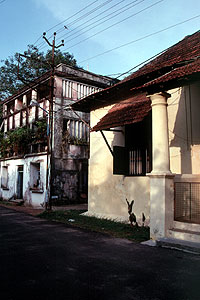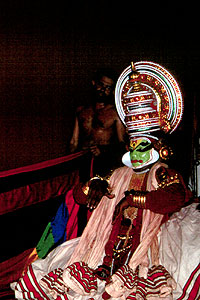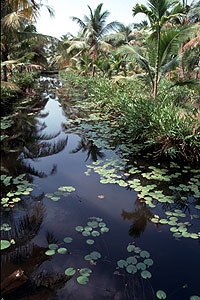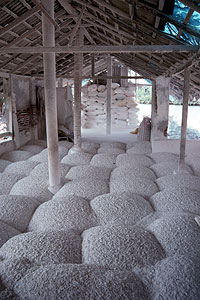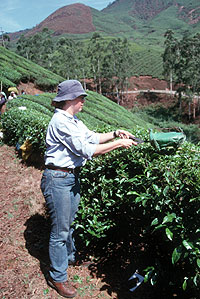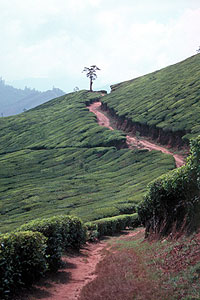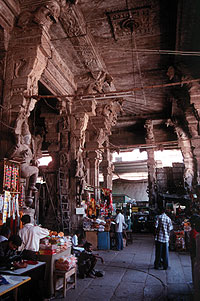Saturday, 3 April 2004
Mumbai, Maharastra, India
We arrived in Mumbai at midnight. Although Mumbai was a pretty inconvenient place to start off a trip through the very South of India it seemed oddly appropriate as is was the starting point for our travels one midnight almost six years previously. Unlike that night when we got off the plane it was not raining, our previous visit being in June when the monsoon was in full swing. In fact that time it did not stop raining for one second we were there. This time it was a hot summery night with a temperature of 27°C.
Remembering the flea pit we had spent the night in that time I had taken the precaution of booking us into the Holiday Inn at Juhu beach, supposedly one of the more glamorous areas of Mumbai and very close to the airport. I had even arranged for a car to pick us up but because of some confusion on their side about which day we were arriving on it failed to turn up so we had to hang around waiting for it to be sent. We then drove a few kilometres through the night which proved a gentle reintroduction to Indian driving. Once at the hotel we were in bed and asleep within minutes.
Sunday, 4 April 2004
Bangalore, Karnataka, India
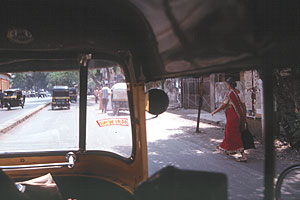
(Mumbai, Maharastra, India)
On waking up I rushed to open the window to enjoy the sea view we had been promised. Instead I found that we were at the side of the hotel with a good view of some uniformed "re cyclers" sifting through a rubbish tip. By craning our necks we could just see the brown sea lapping at the sand just beyond them. It was a beach but the Maldives it was not, however we had just gone there to crash somewhere so we were not too bothered.
We were both a bit unprepared for the two weeks of travelling ahead. Our marriage the weekend before had exhausted both of us from an organisational stand point and had left us with little time to read and plan. However we had come to explore the very south of India which from Mumbai was very far away with only a few widely spread out sites in between. Despite her fear of flying Anna, who had not read a single book until the plane over, had come to the same conclusion as me that an internal flight to Bangalore would save us days. Therefore we had a leisurely breakfast and set about getting to the internal airport, which was fortunately very close to Juhu Beach.
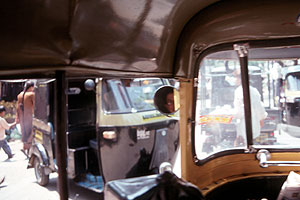
(Mumbai, Maharastra, India)
Outside of the hotel we had our first episode of Indian "Entrepreneurship". The hotel had told us that a taxi should be no more than 150 Rs, when we got outside a taxi driver rushed up and said "no meters" and said the price would be 200 Rs. I started to haggle but Anna disappeared off to investigate a line of autorickshaws nearby. The true taxi of India, an autorickshaw is basically a motor cycle engine powered, open sided tricycle which takes at most two or three passengers. Anna had seen them shooting around the previous night so was very excited about the prospect of taking one to the airport.
Our movement towards the autorickshaws caused a big fuss. We were instantly told us it was illegal, which it was not as autorickshaws are only banned in the centre of Mumbai, and when they could see we were not going to be persuaded the taxi drivers descended on the autorickshaw driver. At one point they even started poking him. I felt a bit bad about upsetting the local equilibrium but we negotiated a fare of 70 Rs and bade adieu to the sea of taxi drivers who were now rapidly undercutting each other in order to get our fare. It may seem a bit odd that we had shifted so quickly into squabbling about £1.50 but we have always felt it important to make it clear to people that they cannot rip tourists off. Also we felt a lot happier when we got out and gave the non-english speaking autorickshaw driver his 70 Rs plus a small tip and his face broke out into a clearly appreciative smile.
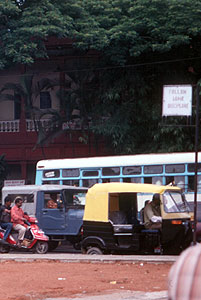
(Mumbai, Maharastra, India)
It was a bit of stupid move to go to the airport so early as we knew the next flight to Bangalore was not until 1550. We thought that there may have been some complexity or queuing involved to get tickets on the spot. Predictably it could not have been any easier and we were looking at three and a half hours with nothing to do. With the centre of Mumbai three quarters on an hour away by taxi and no left luggage counter at the airport there seemed little point doing anything else but sit down and read guide books. As it turned out Anna managed to consume a large percentage of this time. When we went to check in she was freaked out to discover that they had issued her ticket using her father's first name (which for some reason appears in a quite prominent position on Greek passports) as her surname. The reissuing of the ticket took the best part of an hour and everybody, including me, was quite mystified at why she was bothering since it was an internal flight anyway.
The security at the airport was reassuringly tight but very labour intensive. We first had to have our hold baggage x-rayed and then sealed. After checking in we went through the normal hand baggage x-ray and walk through metal detector but the results of the latter were completely ignored and everyone was patted down and scanned with a hand held detector. Finally whilst leaving the exit gate we were scanned with a hand held detector once again. At each stage of the process we got an ink stamp either on out ticket or luggage tag. It being India men had to be segregated from women for both the manual scans and for some reason the women's was done behind a small screen.
When we arrived at Bangalore we got a state controlled pre-paid taxi to the Taj Gateway hotel. I had decided that this time we would spend a bit more on hotels. It was a bit of an abandonment of our travelling principles but it was our honeymoon and the thought of spending it in a string of ropey hotels did not seem very romantic!
After we had freshened up we headed out into the night. Bangalore is a very vibrant city of 8 million people. Some 140,000 of these work in IT for western companies keen to "off-shore" development and maintenance of software to Bangalore's cheap, well educated and English speaking work force. To give you some idea of the scale of the industry Bangalore should be compared to California's silicon valley whose total workforce is estimated at a fraction of Bangalore's at around 20,000.
However despite being relatively well off for a city in Indian terms the area around the central Mahatma Ghandi road was disconcertingly lacking on pavement. Picture the throngs of people on Oxford street two weeks before Christmas and triple the numbers. Then replace all of the people with young Indian male programmers dressed to impress in Chinos and polo shirts. Finally replace the pavement with a potholed muddy road and add several autorickshaws and motorcycles trying to clear a path through the throng with their horns and you have a good idea what a night out in Bangalore is like.
We forewent the experience of the legendary laser show at the NASA bar and headed instead a little further down Church Street to a restaurant called the Coconut Grove. There we had an excellent meal of Tamil and Keralan food. It was possibly a bit too much spice for our system so soon in our trip as was proved the next morning, but we knew that the next two weeks would be an all out curry-fest.
We rounded off the night with a pint at "Pub World" an establishment in which four separate bars: an English pub, a German beer kellar, a Manhattan cocktail lounge and a cactus infested Mexican bar had cunningly been squeezed into a single room. We went into the English pub, the Red Lion, because its wood paneling somewhat deadened the hip hop soundtrack of Eminem, Dr Dre and JZ. Whilst supping our mugs of Kingfisher (the themeing not extending to the beer selection) we watched a group of relatively hip young guys chatting to three girls in saris feeling pretty sure this was the first and last time we would be witnessing such liberated behaviour on our trip.
Monday, 5 April 2004
Mysore, Karnataka, India
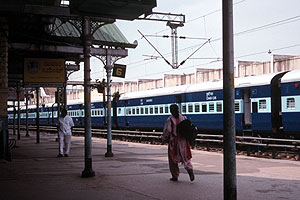
(Bangalore, Karnataka, India)
We got up at 0700 and went for a refreshing swim in the hotel's pool. Despite being in the centre of town it was very quiet and as we did a paltry twenty lengths it seemed as if us and the hawks circling ahead were the only beings awake.
After breakfast we jumped in an autorickshaw and went to Bangalore station to get the train to Mysore. At the station we were quite bewildered to find that the tickets for the train we wanted to catch were not sold at the main ticket office but at a separate booth on platform eight. It took us an unbelievable amount of time to get over the bridge to the platform because we had to fight against a tide of hundreds of people getting off a recently arrived train. When we did get there we found that everyone was getting off a train that was now bound for Mysore but which was just about to leave. When we got to the booth it turned out that it was closed. Apparently it only existed to sell tickets for one specific air conditioned Mysore train which was due to leave in an hour. Having by now missed the more rural train there was nothing to do but sit down and wait.
The train turned up exactly on schedule. However it was clear once it turned up that we were going to have a bit of a dull journey as its windows seemed to be rather small and a cloudy yellow colour making it impossible to take photos and quite hard to admire the view. During a slow part of the journey I attempted to see if the train doors at least had opening windows. They did not however I heard the sound of one of the train's stewards opening the door in the next carriage. Dashing through the join between the carriages the steward stopped me, "what is wrong? Have you finished food?", he asked, presumably in reference to the tin foil curries we had politely refused earlier. I tried to explain that I wanted to take some photos but the more I explained the less he understood and the more worried he got about the standard of the train's catering. In the end I was forced to give up as the train had by now accelerated again making it hard to get a decent photo anyway.
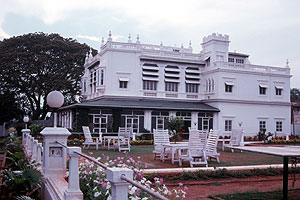
(Mysore, Karnataka, India)
In Mysore we had to arrange our hotel and did so at one of the small manned kiosks labelled STD/ISD which we were soon to find are India's very labour intensive public telephone booths. Once this was done I only had to get rid of a very persistent taxi driver who had been bugging us for ten minutes before leaping in the by now obligatory autorickshaw. When we got there we found that the hotel we had arranged was very nice. It was formerly the palace of a Maharaja's daughter and in converting it to a hotel few of the original features including the original room lay out. This made it a little strange because upstairs there were a couple of large public rooms, one formerly a dining room, and off this were a surprisingly small number of rooms. Anyway we dumped our bags and headed back into town to see the palace of the Maharaja's themselves. For some reasons, which we were not entirely convinced of, the hotel considered itself very environmentally friendly so was called the Green Hotel.
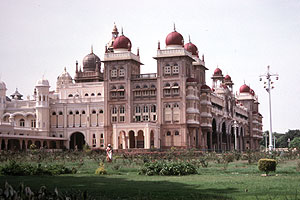
(Mysore, Karnataka, India)
The independent state of Mysore was ruled by a line of Maharajas called the Wodeyars from 1565 until independence in 1947. There was a brief interruption in 1761 when the infamous Tipu Sultan seized power but he was eventually defeated by the Duke of Wellington in 1799. However during his reign Tipu Sultan razed the entire town to make way for a new capital which he never got to build, so when the Wodeyars were returned to power by the British they had nowhere to rule from. When a temporary wooden palace was burned down in 1897 a replacement was commissioned which was completed in 1912 at a cost of 4.2 million Rs.
Getting inside the palace was a bit of an ordeal, we had to remove our shoes and were subjected to a metal detector designed to stop people taking their cameras into the palace. Once inside however we were treated to a series of rooms that in their day must have been breathtaking, but were now sorely in need of maintenance. One, a huge two storey pillared ball room, had a stained glass dome depicting peacocks but a few panels had fallen out at some time in the past and had just been replaced with plain glass. The other problem was that the palace completely lacked furniture so it was very hard to get an idea of what it was like in its heyday. However there were some fabulously intricate ivory inlaid door panels and an open air pillared gallery which looked like it was used by the Maharaja and his court to address his people in the large square below.
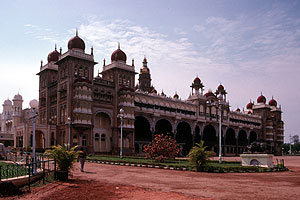
(Mysore, Karnataka, India)
Out of the palace we were once again subject to the hawkers and beggars endemic to Indian tourist sites. We had to ignore them including a guy who followed us around waggling the stump of his arm, which had been amputated just below the elbow, at us. It always makes me feel somewhat guilty to do this, however I was able to turn this guilt into anger at the Indian government who have a growing economy and find the money to fund a nuclear and space program but seem to provide little of a welfare state.
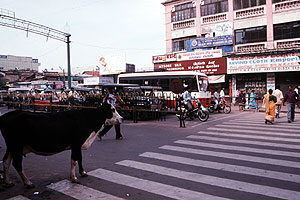
(Mysore, Karnataka, India)
After the palace we went to sample some of Mysore's famous Mysore Pac, a sweet a bit like a very loose fudge, and then had a failed attempt at finding some lunch at a restaurant which turned out to be closed. Outside the restaurant we flagged down an autorickshaw but no sooner had we started when another autorickshaw shot in front of ours blocking the way forwards as it appeared that autorickshaws have no reverse gear. We had caused yet another fight, this time because we had not noticed a rank of autorickshaws some way down the road who felt that they had the right to our custom. There was lots of shouting so I simply walked off. Our autorickshaw driver disengaged himself from the fight and cannily tailed us, so when we were out of sight of the rank we simply climbed back in. It may seem not particularly fair on the drivers who had been waiting in the rank, however the aggressiveness of the rickshaw Mafia in front of us was so disgusting that Anna and I thought that cheating was the right thing to do.
After our autorickshaw ride we went to chill out and write diaries in the open air bar of our hotel. We then had an excellent curry whilst watching the sun go down, sitting at a table on the lawn of the palace. This proved an excellent antidote to the chaos of the streets of Mysore and we went to bed very, very full.
Tuesday, 6 April 2004
Kakabe, Karnataka, India
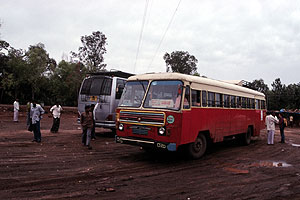
(Mercara, Karnataka, India)
We woke up in the morning to the sound of rain. There had been a thunder storm in the night and it was still raining pretty heavily. We had decided that although the hotel was nice we had not exactly fallen in love with Mysore and so had decided to head out that morning rather than use it as a base for a couple of day trips. Next on our itinerary was Kodagu, a small corner of Karnataka which had until recently been known as Coorg. Before we had left England I had read a book called "On a Shoestring to Coorg" written by Devla Murphy about her travels in the area during the seventies. From the book it had certainly seemed like a very unique part of India.
First stop was Madikeri, formerly known as Mercara. We jumped on a state bus from Mysore bus station and prepared ourselves for either four or five (depending who you talked to) hours of fun. Once on the bus it swiftly came back to us why travelling on state buses in Asia is neither very comfortable nor safe. Imagine a US school bus, having come to the end of its life, being sent to India, re sprayed and put in the hands of a maniac. Then imagine the bus being driven at 60 mph along stretches of tarmac barely wide enough for a single car. Finally place a series of highly painted trucks coming from the opposite direction and you have got a fairly accurate picture of what being on the bus was like. I remember seeing a program where the presenter explained that the Hindu mentality towards blind overtaking is based on the belief that there will not be a car coming in the opposite direction unless it is your day to die. Anyway it cannot have been our driver's day as through some very nerve wracking driving he managed to cut the trip down to three hours.
Apart from the sheer terror the trip had no real highlights until we reached the edge of the Kodagu region. Literally within the space of a few metres the unordered and squalid mess of the Indian countryside vanished to be replaced with well kept fields and groves of banana trees. As we got closer to Madikeri the countryside became more mountainous and the banana trees were replaced by coffee bushes. By some cunning timing we had arrived during the few days when the coffee was in bloom so we spent the last part of the journey taking in the view of miles upon miles of mountain slopes covered with millions of white flowers. We were also treated to the quite overpowering aroma of the coffee bloom, which was a nice break for our noses.
We realised at once that Coorg is a veritable paradise within the mess that is the rest of India and its inhabitants, the Kodavas, a breed apart. However Madikeri, its capital, proved a bit of a disappointment as just like most Indian villages it was a mess of dirt tracks with no real landmarks to orient ourselves. As soon as we exited the bus station we got lost and had to ask for directions. Not for the first time we found ourselves thankful of the fact that a large proportion of Indians speak perfect English. After a little more walking we found what we were looking for, a travel agent called Vinod who had contact details for over 200 coffee plantation home stays in the area.
After some discussion we choose a place in a village called Yavakapudil, near a village called Kakkabe nestling at the foot of the highest peak in the Coorg. Unfortunately this meant boarding another bus, this one going to the middle of nowhere via a serious of switchbacks and even narrower roads. Fortunately we had noticed that outside of cities 90% of traffic appeared to be either trucks or buses and as we got into increasingly more rural and out of the way places even these started to peter out. Halfway through the trip we stopped at a small village and were pestered by a beggar, who spent ten minutes doing everything a part from actually poking us in an attempt to get us to notice him. It appeared that despite being one of the richest regions of India the Coorg still had its poor. Despite this however we had a good journey and managed to enjoy some of the lush jungle scenery.
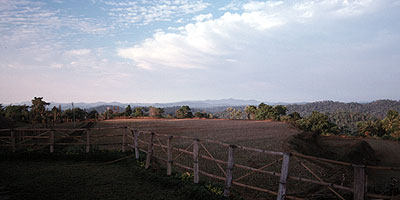
(Kakabe, Karnataka, India)
When we got to Kakkabe we were pointed in the direction of an auto rickshaw and had to take it as a matter of faith that he was taking us to the right place instead of being driven to the middle of nowhere and then mugged. Our faith turned out to be warranted, Kings cottage was a small coffee and rice plantation with a magnificent view out over the whole of Coorg. It had a separate guest bungalow which although a little spartan had an excellent open verandah from which to enjoy the view. The owners, Viju and Vivek Apparanda were very eager to please, instantly plying us with biscuits and their own coffee. We chatted to them for a while and then set out to see a local attraction, the Nalnad Palace.
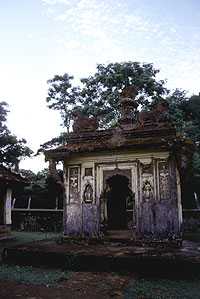
(Kakabe, Karnataka, India)
The Nalnad palace turned out to be a slightly derelict hunting lodge which clearly was a playground for the local children. The employees of a local hotel were also hanging out there and as we were clearly the only thing that had happened all day they followed us around and generally annoyed us until we decided to leave. We went back to Kings cottage to read and watch the sunset from our verandah.
After a very nice vegetarian meal, spent watching lightning across the hills near Madikeri, our hosts once again popped down to talk to us. This time we were able to find out a bit more about the Kodavas. One of the main things that separates them as a people is that they are not Hindus and instead venerate their elders. Families traditionally live in a compound called an Ain Main which is square with a large central atrium open to the elements. Within each Ain Main is a shrine with a lamp which represents the spirits of the family's ancestors. Richer families, like our hosts, who have built more contemporary dwellings still maintain the Ain Main as a family shrine. They also have their own language so children are forced to learn three languages in schools, their own, English and the state language Kanada.
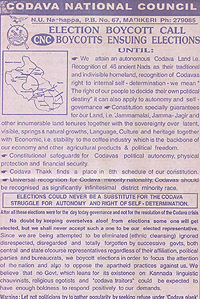
(Kakabe, Karnataka, India)
We had come to India in the run up to the national elections which the Kodavas had decided to boycott them en masse. Our host showed us a leaflet which explained that it was impossible for a politician representing Karnataka as a whole to adequately reflect their needs. Instead they were calling for Coorg to become an independent state as it had been for most of its history until 1956 when it got swallowed up by Karnataka. This independence would also straighten out the tax situation, as the Coorg is the richest part of what is a fairly poor state the Kodavas often think they are paying more than their fair share.
All of this fitted in very well with what we had seen, that the Kodavas were indeed a very different bunch of people. Although during our stay there we had seen some poverty it was nowhere near on the same scale as the rest of India and on the whole everything, the land and the houses, was well looked after. Whether this was as a result of more fertile land, a more temperate climate or their religious beliefs was another question. After our chat we went to bed and slept on the matter.
Wednesday, 7 April 2004
Kakabe, Karnataka, India
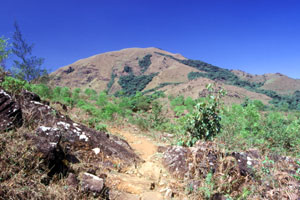
(Kakabe, Karnataka, India)
We had a slightly restless night, perhaps as a result of the extreme quietness of the place. We were woken at 7am by the light of the sunrise streaming in through the window, the front of all houses in Coorg facing east. After a quick breakfast we set off for the peak of Tadiandimol, which at 1745m is the highest peak in the region.
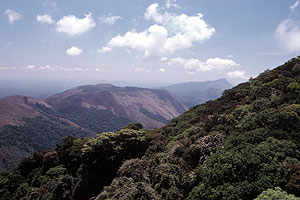
(Kakabe, Karnataka, India)
The walk started out very easy passing through the jungle on a very broad road. We passed a few wild bee hives, Coorg being famous for its honey, climbing steadily upwards. About half an hour in we passed a team of workers who seemed to be in the process of tarmac'ing the track we were on by hand, without the benefit of western machinery. The process involved laying out stones, pouring some creosote on the stones, running a steam roller over the track, pouring a layer of asphalt on it, putting some finer grit on it then steam rollering it again. Everywhere men were boiling up cauldrons of oil. The end process was pretty professional but I wondered how long it would be before it became just another pot holed track.
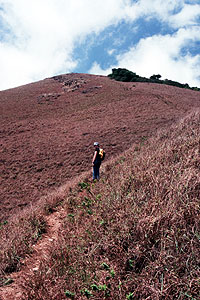
(Kakabe, Karnataka, India)
About an hour in the going got a lot tougher. The terrain became more like scrub land and the gradient sharply inclined. The view however was stunning and as there are very few areas of Coorg that are not covered by jungle I imagine it was quite unique. From the top we predictably could not see the Indian ocean but we did get a good 360° view of Coorg before the cloud started to set in. We had a lunch of onion pakora made by our hosts and then headed back down the mountain.
On the way down we stopped to filter some water from a stream. At the stream it suddenly dawned on me why Indians had such great problems with the purity of their water supply. Whilst very environmentally friendly, not using toilet paper has the disadvantage that if you get caught short in the country side you need to be within waddling distance of a stream. Thus it was that halfway up a mountain we found the stream littered with toilet paper and had to climb a long way upstream before we could even start filtering.
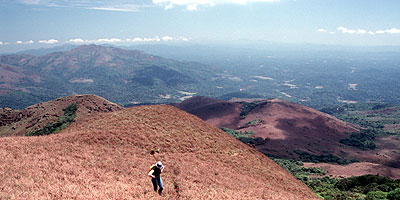
(Kakabe, Karnataka, India)
By the time we started got back down to Kings Cottage the sun was beating down and we were pretty exhausted. We were preparing to hop straight into the shower when Anna noticed that my heel was bleeding profusely. One quick look at the un coagulating flow told me that yet again I had been attacked by leeches. In retrospect it was a bit stupid not to check immediately after our stream climbing as this is where you would expect leeches to hang around.
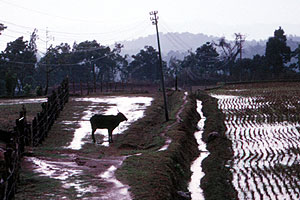
(Kakabe, Karnataka, India)
After all the blood was mopped up we did our best to recreate the days of the Raj. We sat on our verandah drinking afternoon tea whilst staring out over the hills to Mysore in the distance. As if on queue the afternoon's thunder storm started up. We sheltered under out verandah as the short lived but very heavy storm passed overhead, reading, writing diaries and sipping tea. After the storm some cows which had escaped into a rice padi provided me with a good photo opportunity. Following this we had yet another stunning sunset and another great home cooked meal.
Thursday, 8 April 2004
Kochi, Kerala, India
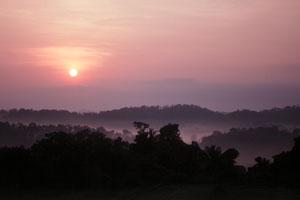
(Yavakapudil, Karnataka, India)
Next on our list of places to see was Kochi, formerly known as Cochin. From where we were there were no direct links (in fact there were few links to anywhere!) but we thought that with a bit of luck we could do the trip in about eight hours. Just to be on the safe side we got up very early which allowed us to catch a terrific sunrise. Then after a quick breakfast our hosts drove us down to the bus stop.
The first bus journey was fine, a short drive through coffee plantations to Virjapet, a largish town in the South of Coorg. This is where our troubles began. Instead of an orderly bus station Virjapet had a square which buses drove through picking up passengers on the way. We asked a few people about the bus to Cannur but their seemed to be some confusion. So when after fifteen minutes wait someone told us "here is bus" we leapt on it without asking too many questions. When the conductor came along he told us the bus was going to Thalasseri. Since we were by this time pretty much wedged in our seats, and since it seemed to be one stop closer to Kochi on our railway map than Cannur we thought we would stay put.
It turned out we were very wrong. After an hour and a half of winding down through mountain roads we got to thalasseri, a very hectic and messy town on the Malabar coast. We got an autorickshaw to the train station (some 300m from the bus station, but the rickshaw driver took us the scenic route so that we did not look too stupid). However once in the train station it was clear that nothing much would be happening there for a while. We asked around and found that the next train was not leaving until late evening. We would, we were told, be much better off going to Cannur and catching a train there. We walked the short route back to the bus station and jumped on our third bus of the day.
One thing we noticed with our bus journeys was that no matter what we always seemed to end up with the fastest bus driver in town. This driver overtook everything, in a thirty minute journey he was only overtaken once and then by a fellow bus driver who he was clearly racing with. The excitement was heightened by the fact that all the side windows of the bus had been removed leaving it free to the 50mph wind. At Cannur train station things did not start to improve. It was 1300 and the only train leaving the station was a 1545 "Express" - we had little choice to sit and wait.
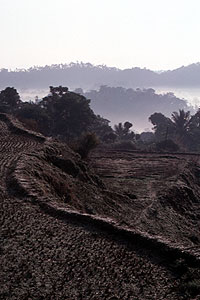
(Yavakapudil, Karnataka, India)
The train departed on time and at first we were very excited. A six hour journey along the Malabar coast beckoned and since Indian trains are a lot more open we did not have the inconvenience of being cooped up with our knees around our ears. Even the air conditioning seemed a done deal with open windows and ceiling mounted fans. However it turned out to be an ordeal. Firstly there was only a single track for a good third of the journey which meant long waits at for oncoming trains at various stations. At one station we had to wait 45 minutes. On top of this we had sat the wrong way round so did not get the benefit of the breeze so I spent most of the journey sweating in the 35°C heat. All in all it wasn't very pleasant and I began to question why we were doing this on what was, after all, our honeymoon.
We finally turned up at Kochi an hour late at 2245. We then had the fun of finding a hotel as dialling long distance had not worked when we had tried earlier from Cannur. Fortunately we found a room in a hotel in Fort Cochin (the island on which the historic Portuguese/Dutch port is located). As the ferries had stopped at 2130 we were forced to stump up for a very long taxi ride over various bridges to get there. When we finally got to our room I was amazed to see that something had finally gone right for us. Whilst not part of the hotel's renovated Dutch building, our room was in a new building which had been finished in a similar style with wood floors and furniture. Not that we spent much time admiring it - after a quick beer we went straight into a deep sleep well deserved after what had been fifteen hours travelling.
Friday, 9 April 2004
Kochi, Kerala, India
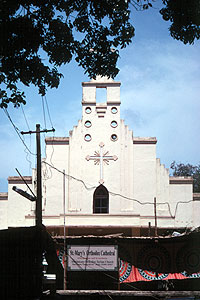
(Kochi, Kerala, India)
I am not sure how we managed it but we completely managed to idle away the best part of the day. We spent a long breakfast discussing our itinerary. The horror of the previous day had put me off any more long haul journeys so we needed to adjust our plans slightly. We then went over to Ernakulum, the land side of Kochi. This involved a couple of enjoyable ferry rides via another island called Vypeen. The ferry dropped us quite a long way out of the centre of town so we were faced with a long walk along the shorefront promenade. The promenade was packed full of Indian families, presumably on holiday. As we neared the centre we came across an Assyrian Orthodox Church. Since it was Good Friday Anna decided to pop inside to take a look. I was outside however there were so many people that the service was taking place both in and outside the church. The singing sounded exactly like an orthodox service except when you listened in you could hear the words were not Greek.
After that we wandered around for a bit but soon realised that it being 1400 everything was shut for lunch. Since it was quite hot we decided to get some ice cream at a very traditional ice cream parlour. We then got some cash and without much else to do decided to head back to Fort Cochin.
Back on the island I decided to invent a "short cut" back to the hotel which turned out to be a rather long meandering route via which we got to see a lot more of the island than we planned. We started off in what was, relatively speaking, the slums and ended up walking through very pristine avenues of houses not unlike those you would find in Greece (i.e. they were all nice but completely different).
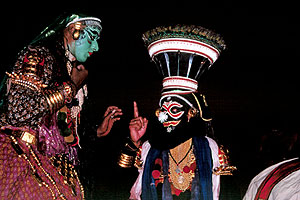
(Kochi, Kerala, India)
After this we had a brief sleep and then went down to the beach to watch some Katakali dancing. This proved quite interesting as unlike a lot of similar folk dancing performances we had seen over the years, after an hour spent watching the dancers apply their make up, they spent an hour explaining the various moves of Katakali dancing. From this it appeared that there are nine basic facial expressions ranging from love to hate which are combined with a form of sign language so that the story is mimed. Thus the pretty obvious sign for "come here" was the dancer sweeping their hand towards himself. The dancer then combines with the hate face to make it an order, i.e. "Come Here!", or the love face to make it more seductive. We were also shown some other hand gestures such as "how the bee sips nectar from the flower". But since this was a ten minute mime in itself I was glad that the story that we were going to see was not that complex as it would have gone on for hours!
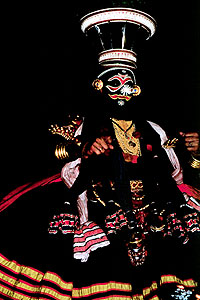
(Kochi, Kerala, India)
The performance itself benefited greatly from the actors' explanation. We had a photocopied outline of the story in English. It was taken from the Mahabharata and was about Shiva being disguised as a barbarian and having a fight with a hunter for killing a pig. The costumes were amazing and the music, some pretty intensive rhythmic drumming accompanied by singing, was as thrilling as the acting. We had an excellent time and were able to follow a lot of the action even with our limited understanding.
After the Katakali dancing we had dinner at what was supposedly Fort Cochin's premier boutique hotel. It was very nice but the service was appalling. We had live North Indian classical music throughout the meal courtesy of a very skilled sitar player. However by the time we finished our main course it was nearly 2230 and the musicians had packed up and left. Added to this although it was an open air restaurant it was in a closed courtyard and the combination of no breeze and a humid 35°C meant that I had been sweating profusely throughout the meal. We decided to call it a night and skipped dessert!
Saturday, 10 April 2004
Kochi, Kerala, India
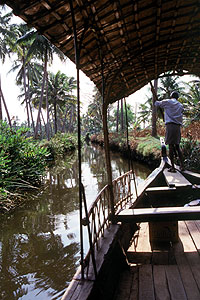
(Kochi, Kerala, India)
We had booked to go on a "backwater cruise" the evening before. This involved waking up at 0800 and getting a minibus about fifty kilometres south to a place just north of Vembanad Lake near Kottayam. The drive as always was fairly manic. When we finally got there we found a river on the banks of which waited a boat with a woven coconut leaf roof. Funnily enough the boat turned out to be a punt. Our guide, Praveen, sat and chatted to us whilst two other chaps punted us along various rivers and man made canals with 7m long bamboo poles. It was very relaxing as we had the boat to ourselves and the breeze off the water served to cool us down in the 35°C temperatures.
After a while we turned down a narrow canal to visit a coconut plantation. Here we were shown how the locals make toddy, an alcoholic drink sapped by placing a round container over the bud of a coconut palm. What was more interesting was the way in which the coconut palms had been planted. They were in rows with smaller water channels in which water lilies seemed to thrive. It was a very idyllic scene, We were given a coconut to drink from and then set off again.
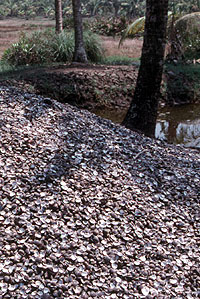
(Kochi, Kerala, India)
On the side of a larger channel we visited a very primitive calcium factory. One of the dietary staples of backwater dwellers was the meat of small muscles that grow on the bottom of the lake. This generates large numbers of shells which are then taken by the factory, mixed with carbon, baked in a fire until they turn white and then hosed with water - the chemical reaction turning them into calcium hydroxide powder. It was a mildly interesting chemical process, what was more fascinating was the fact that in the backwaters they have very few resources so nothing goes to waste. As well as muscles it seemed that every part of the coconut is used to make rope, oil, boats, houses and of course in cookery.
Next up we were taken to a typical backwaters village which I found a little intrusive but the villagers seemed happy enough but the villagers seemed happy to see us. We saw a boat in the process of being repaired. The planks of backwater boats being stitched together with coconut husk rope which periodically needs to be replaced. We were even shown the process of making the rope. The other thing that the village allowed us to do was to see a lot of the trees and plants used for cooking. We were able to see hoe cashew nuts grew - on trees with the most amazingly foul smelling fruit. As we were leaving another group, who had been tracking us for a while, turned up. Fortunately however this was the last we saw of them.
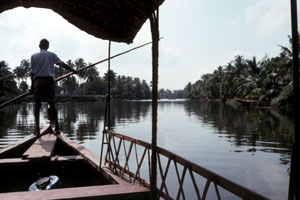
(Kochi, Kerala, India)
The next bit of the cruise was just a leisurely punt through more canals and over a corner of the lake to where we were to have lunch. This bit was very peaceful because as with the canals there were no motor boats, just punts and sail boats. Because it was so quiet we were able to see some of the local wildlife. We even saw several Indian kingfishers which were an amazing metallic blue, however we were never able to get close enough to take a photograph.
Lunch was an excellent vegetarian Keralan wedding banquet, several curries served on a banana leaf. It was however marred by our guide taking us into a small airless hut on an island to eat it rather than on the boat which benefited from a breeze from the lake.
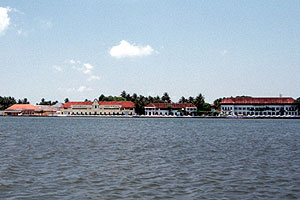
(Kochi, Kerala, India)
We then had a leisurely cruise back to the minibus. Our guide was very laid back and we chatted to him about many things. We found out for example that although divisions of caste no longer exist in jobs, education etc. they are still seemingly enforced when it comes to marriage, We also found out that the job situation in Kerala in very dire. It has the highest literacy rate in the country but everyone is forced to go to the gulf states to find work. Our guide for example had studied economics at university and short of leaving the state tourism was the only job he could find. Anyway he was a nice chap and he was very relaxed about the tour, as opposed to jabbering facts at us as some guides do.
Back in Fort Cochin we again had a short midday nap and after that went for dinner. This time we went to the restaurant of the Brunton Boatyard, Fort Cochin's most expensive hotel, which had the benefit of an outside terrace overlooking the harbour. The meal was very good and by English standards still cheap.
Sunday, 11 April 2004
Munnar, Kerala, India
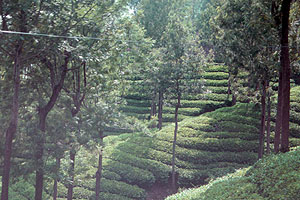
(Munnar, Kerala, India)
We left early-ish in the morning to head for the coolness of the mountains again. We had arranged to stop at Munnar, a tea plantation at an altitude of 1500m, midway between Kochi and Madurai in Tamil Nadu. We got on a relatively empty bus and had, for once, a fairly leisurely drive up. Again the scenery was breathtaking but especially the last few kilometres as the jungle gave way to an open expanse of tea bushes. Although I have seen pictures of tea plantations before I was not prepared for the sheer scale of it. Literally every slope was covered in row upon row of bushes and this neat arrangement gave the slopes an amazing texture.
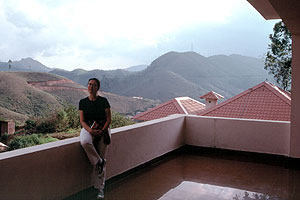
(Munnar, Kerala, India)
Our hotel was a fairly nice state run hotel - a sprawl of smallish buildings occupying a ridge overlooking the town. We went for a short walk to explore the town. and bought some tea at the local tea factory. The plantation was run by a company called Tata which has many diverse enterprises in India from tea to manufacturing cars and trucks.
After this we both had an ayuduveric massage. This consisted of being dressed only in a 10cm wide strip of bandage, being covered in hot herb infused oil and then pummeled with a bag of herbs. It was very relaxing however the end of the hotel we were in was a bit run down. The massage rooms were like communist prison cells, the swimming pool was out of order and the gym hosted a rusting mess of equipment which gave it the feeling of a medieval torture chamber. This was followed by dinner surrounded by a swarm of too attentive waiters, but our relaxed state prevented us getting too annoyed by them.
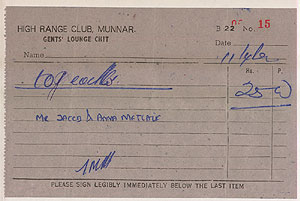
(Munnar, Kerala, India)
After dinner I could not pass up the opportunity to visit Munnar's "High Range Club". When Munnar was run by the British this members only club must have been bursting with gin swilling, gout ridden plantation owners. Now however it was populated by Indians who were having an extremely good go at being more British than the British. After a short autorickshaw drive we were met by the manager, whose English was better than 90% of the people in Britain, paid a small subscription fee to become members of the club and then armed ourselves with two large gin and tonics.
Unfortunately, it being Sunday, the club was relatively empty. This however meant that the manager was happy to let Anna see the "men only" bar. This turned out to be a 30ft long room whose walls were packed with stuffed animal head trophies, pith helmets and old black and white photographs of hunting expeditions. Unfortunately we were unable to enjoy our membership for more than one gin and tonic, the club was in the middle of nowhere so we had paid the autorickshaw driver to wait and drive us back to the hotel.
Monday, 12 April 2004
Madurai, Tamil Nadu, India
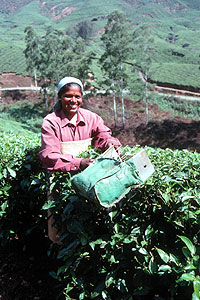
(Munnar, Kerala, India)
We were meant to get up very early but after a lot of messing around we did not get out of the hotel until about 0830. We went to the market and found Munnar's famous "free information" service, the now ancient Mr Josef Iype. As with the other people who feature in guide books we had met in the past he would not stop going on about it showing us photocopies from both the Lonely Planet and the Rough Guide. He was more reticent about the fact that he also made an appearance in "On a Shoestring to Coorg" which, as mentioned earlier, was written in the seventies. Anyway after establishing his identity he gave us some very sage advice about getting too Madurai and when we asked about tea clipping he found an autorickshaw driver, gave him instructions and negotiated a very good rate. We bought some postcards from him as thanks for his help.
The drive up into the mountains with the autorickshaw was very scenic. We went up a tea lined side valley which had a babbling stream running down its centre. After about 4km we got out, paid the driver and started our walk back. It did not take long to find what we wanted. Paths criss crossed the mountainsides and walking along one we were shouted at by some clippers above us. They beckoned us to climb up through the rows of tea, something which gave us an insight into how difficult their job is as we had to pull ourselves up by the trunks of the squat bushes.
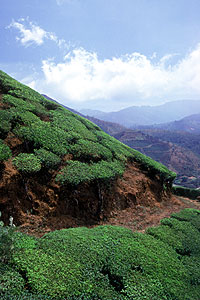
(Munnar, Kerala, India)
When we got up to the clippers they were very excited, insisting that we clip some tea and posing for a variety of photographs. They wanted us to post the photographs to them however no-one had a pen so someone scurried off down the mountain to get one. Unfortunately the only person with a pen seemed to be the foreman who clearly guessed that something was disturbing the clipping. He soon turned up and he was a very fat Indian chap with a moustache curled up at the tips. He looked disdainfully at us but did not say a word. Everyone hurried back to work and we carried on walking.
Walking back through the tea was like navigating a 3D maze. Everywhere paths followed contours, zigzagged down or climbed over saddles. All around us the tea, probably the world's largest and most frequently trimmed hedge, hemmed us in on all sides. We went around a couple of side valleys and over a saddle and eventually caught site of Munnar, The sun had been pretty intense but walking through the tea plantation the walk had been very pleasant and had seemed to take no time at all.
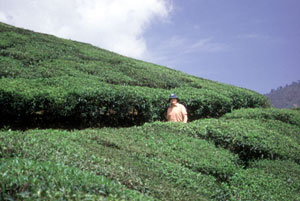
(Munnar, Kerala, India)
Back in town we had to catch a bus which, depending on who you talked to, was at some time between 1200 and 1230. It did turn up at 1230 but seemed to be so full that we were not going to get on. Some people we had been talking to told us that the problem was that the people on the bus were trying to get off but could not because of the throngs of people trying to get on. By the time we had got on and dumped our rucksacks by the driver the only seats together were at the front of the bus, which Anna could not cope with as you see too much of the oncoming trucks, and on the back row. I remembered from travelling before the back row is about the worst place but could not persuade Anna to take the front.
It turned out that my feelings were correct. The problem with the back row is that the motion of the bus is amplified which when you are going up and down hair pin bends on a mountainside is a real issue. This is worsened by the fact that if you are sharing the back row with four other people on what is a single plastic bench they tend to slam into you on every turn. On this particular trip we had an additional nuisance in that the person next to me seemed to suffer from sleeping sickness and permanently had his eyes closed and lolled his head from side to side. This not only annoyed me but also the fat conductor sitting on the other side of him. We both had to continuously punch him to avoid having his greasy head resting on our shoulders
Luckily someone got off after about an hour and by some fast manoeuvring was able to shift across and get a newcomer between me and Mr Sleepy. However this put us closer to yet another problem, a 1000 watt speaker in the back corner of the bus banging out the songs and even more annoying dialogue of a Bollywood (well actually Madras produce Tamil) blockbuster. Then disaster struck as the newcomer also fell asleep and started to loll. However by tensioning my body correctly I could keep the newcomer's head angled towards Mr Sleepy and so play the two of them off against each other. It was a very uncomfortable four hours and especially annoying since we were driving through the highest mountains in the South and could not enjoy the scenery.
After four hours careering down the switchbacks we reached a place called Theni and boarded a bus for Madras. This bus made no bones about what it was, it was a "video bus" in shiny chrome with two televisions and speakers all along the bus. However we got to choose our seats this time and which made the nightmare a little more bearable. This time the main problem was that the driver clearly had his brake and horn swapped around. Instead of slowing down he would sound his horn and instead of only using his horn in his emergencies he would only use his brakes when we were all likely to die. His horn usage was worsened by the fact that it was a brand new bus and had been equipped with a horn worthy of a monster truck.
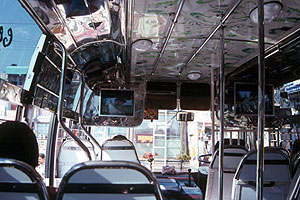
(Madurai, Tamil Nadu, India)
The TV's soon became irrelevant as so many people got on that it was impossible to see the movie. For entertainment however we were able to witness one of the curious facets of Indian behaviour. It appears that no matter how needy someone is no-one will give up their seat for them. On this bus a pregnant woman got on further up and had to stand for half an hour until she got off. We had seen this before with women and old people but this was a new low. The bus also featured a persistent vomiter and a cat fight between two women. By the end of it Anna and I agreed that this was no way to spend a honeymoon and that Madurai was to be the last stop.
Of course the fun did not stop at the bus station. We had a large row with the Madurai rickshaw Mafia about how much it would cost to take us to our hotel. We attempted to take another autorickshaw but even then the local "fixer" got in the front of the autorickshaw with the driver to take a cut of the profits after we were dropped off. When we finally got there the hotel turned out to be just the medicine we needed. We had checked into the Taj Garden Retreat, the refurbished Raj era mansion of the Harvey family who had at one point owned most of the cotton mills in Madurai. It occupied its own private hill and had an excellent view over the whole of Madurai to its temple, which we were able to enjoy over an excellent dinner. All in all it provided a honeymoon level escape from the horrors of the day's journey.
Tuesday, 13 April 2004
Madurai, Tamil Nadu, India
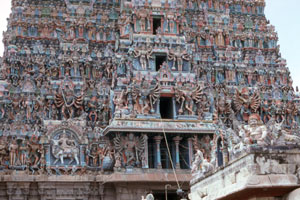
(Madurai, Tamil Nadu, India)
We went for a swim first thing in the morning and then girded our loins for the descent into Madurai with a big full English breakfast. Madurai was pretty chaotic and not helped by a series of very manually intensive road works. When we got to the temple we had to leave our shoes, and a raft of potential "Guides", outside. Inside we immediately descended into chaos. Normally something like ten thousand people visit Madurai's Sri Meenakshi temple every day. However the 13th April was one of their many festival days so there were a significant amount more. We entered via the North Gopuram, a 46m high tower covered in thousands of garishly painted carvings of multi armed gods, animals and buildings. The temple has twelve such gopurams which are lit up at night and it was these that we had been able to see from our hotel the night before.
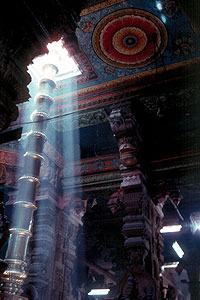
(Madurai, Tamil Nadu, India)
Through the Gopuram we went across a courtyard, dashed past an elephant dispensing blessings into the Kambathadi Mandapam, a thousand pillared hall surrounding the Sundareshwara shrine. Entering this hall was like entering the set of an Indiana Jones film. In a large, smoke blackened, rabbit warren of a room activity raged at a variety of shrines. People smeared and threw clobs of ghee at statues, thousands of tiny oil lamps were dotted around the place, people milled around in a very confused state and all the while a priest droned what sounded like "Om nom shivi" repeatedly over a crude PA system. It was very dark but the ceiling had been pierced around a huge golden column (maybe a lingam but it was difficult to tell) and so light came down illuminating it with laser sharp rays of sunlight. I managed to take a long exposure photograph of the scene and the amazing thing was it bought out the fact that the ceiling, rather than being dark, was painted in a riot of colours. There was an overpowering smell of burning ghee and the floor... well it did not bear thinking about what we were slipping around bare footed in! The atmosphere of the room was incredible and we kept on revisiting it in our travels around the temple.
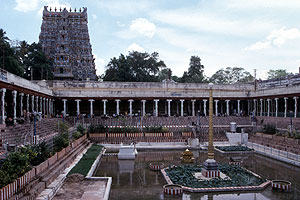
(Madurai, Tamil Nadu, India)
Next we found the Golden Lotus tank which had unfortunately been drained of water, but being open air provided a pleasant break from the darkness. After this we wandered around relatively clueless as to what we were looking at and just marvelling at the chaos around us. As with most Hindu temples the inner sanctums were closed to us but we managed to sneak the odd peek and once again saw the glow of gold illuminated by piercing shafts of light.
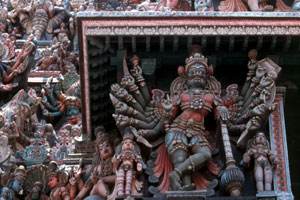
(Madurai, Tamil Nadu, India)
There were all sorts of activities in the temple complex including a market where the most amazingly kitsch votive offerings were sold along with hundreds of garlands of flowers. Finally we entered a huge, so called "thousand pillar hall" in which there was a very haphazard museum which consisted of an array of dusty artefact dumped into a room with absolutely no explanation as to what they were.
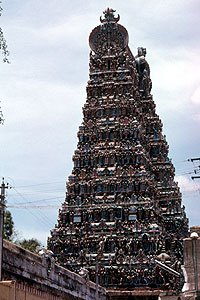
(Madurai, Tamil Nadu, India)
After the temple we dived out into the chaos of the streets to find a juice bar. The temple was shutting at 1230 and the next highlight of Madurai, the Tirumalai Nayak Palace was also closed for lunch and was not opening until 1400. We hunted around a bit and eventually found an okay place with some fans and sat down and cooled down for a while. After this we headed towards the produce market. This turned out to be a pretty horrific fly ridden sort of place and most people had shut up their stalls and left quite a while ago. However we were only walking through to get to the flower market, up some stairs in a concrete building in the middle of the produce market. This was definitely nicer, traders sitting around with huge sacks of flowers of different colours, selling them by the kilo to the temple garland makers. However it was somewhat marred by the fact that the floor was covered in a one inch mulch of rotting, putrid flowers that squelched under foot - and rather stupidly I was wearing sandals!
After this we went to the tailors market. Housed in what used to be a temple, dozens of tailors with sewing machines sat opposite rows of stalls of cloth merchants. We had seen similar operations before and although we toyed with the idea of getting a skirt for Anna made to order they could not quite find any material to suit our, what they probably thought, difficult tastes.
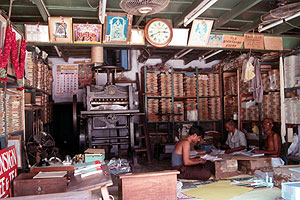
(Madurai, Tamil Nadu, India)
When we finally got to the temple we found that for no apparent reason it was not open that afternoon. However it looked very dilapidated so we were not sure that we had missed out on much. So we carried on exploring the streets. One great find we made was a book binding shop. It had a crazy old wrought iron press from Oxford and a bunch of guys removing paper from cheap exercise books, stamping a page number on each page then binding them in a decorated hardback cover. We struggled a bit to understand what they were doing but the end product was nice so we ended up buying one in the end.
At about three we decided to go back and spend the afternoon by the pool at the hotel. The hotel was as usual the complete polar opposite to the chaos of the town below and whilst sipped our gin and tonics on the lawn that evening Anna and I had a very lengthy debate about the gap between rich and poor.
Wednesday, 14 April 2004
Rameshwaram, Tamil Nadu, India
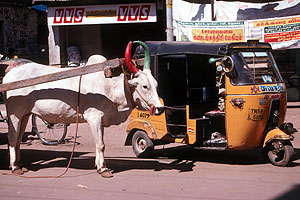
(Madurai, Tamil Nadu, India)
In retrospect it was the only stupid idea we had on the whole honeymoon. We had originally set our hearts on going to the temple at Rameshwaram, a town on a small needle shaped island which reaches out from the east coast of India to almost touch Sri Lanka. We had originally planned to travel the 180km from Madurai by train, six hours each way with a night in between. Our recent experiences had made us rethink the whole idea a few days before, however when we had arrived at the hotel we had found a leaflet listing all the possible day trips from Madurai and one of these was to Rameshwaram so the plan was restored.
We were a bit confused about how it worked but it rapidly became apparent that what we were doing was hiring a car with a driver for the day. It would take about three hours each way and we would be taken around a few places in Rameshwaram. Since this already sounded expensive we balked at hiring a guide as well especially since we prefer to explore these places under our own steam.
After a 0630 start the drive there was very long and uneventful. What was worse was that the car had a fearsome air con unit and Anna started developing a cold. On top of this our driver had a very limited command of English, which was surprising as we thought it was a pre requisite for getting jobs in anyway connected with tourism. His vocabulary consisted of the words "Vehicle", "Backwards", "House", "Temple" and "River" joined together in crude sentences using the words "Your" and "This". For example "Your house your vehicle?" meant "do you have a car in the UK?". This made casual conversation difficult enough bout when it came to arranging our day it made life practically impossible. Anyway after the drive he left us in the middle of Rameshwaram with instructions to meet him back at the car at 1230 - well he actually said "Your vehicle backwards your house twelve and a half" but by then we were getting to understand.
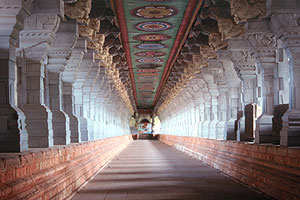
(Rameshwaram, Tamil Nadu, India)
The temple was an utter disappointment. The guide book had said it's main attraction was a pillared hall that ran around the outside of the temple for a total distance of 1.2km. What it failed to say was that this was the only bit of the temple non-hindus were allowed to enter. The history books had shown sepia tinted pictures of crumbling columns extending to infinity. What was not pointed out that the columns had been replaced with cement replicas and that with your incredibly expensive camera license all you were allowed to take a picture of was only one of the lengths of hall, unsurprisingly the least well lit and pleasant of the four.
We walked around the pillared hall in about twenty minutes and then were left wondering what to do. Pilgrim watching was meant to be the thing to do but for some reason there were very little of these. The only interesting facet of the temple were the illustrations on the ceilings of the halls. One set depicted the story of the temple. Apparently after rescuing his wife Sita through the killing of a demon king Rama was told to atone for his sins by worshipping the god Shiva. Not having a lingam to worship with his monkey general Hanuman was dispatched to the Himalayas to fetch one. Whilst he was gone however Sita fashioned one from sand and the ceremony went on. Understandably the monkey was a bit miffed on his return so Rama mollified him by insisting that pilgrims should always prey at his stone lingam in the temple before going to the beach to worship sand lingams.
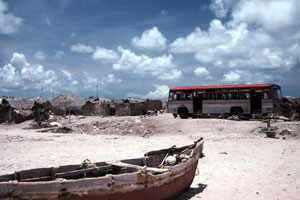
(Danuskode, Tamil Nadu, India)
Having seen all we could at the temple we decided to follow in the pilgrims footsteps and go to the beach. Again we were disappointed as their was no-one doing anything at all with the sand, they were mostly bathing fully clothed in the sea. This seemed like a very bad idea considering what was floating in it but I guess such is the price of religious devotion.
After this we had lunch then found our driver who was a bit surprised to see us back so early. We then had a conversation with him regarding our next destination, Danuskode, which was on the very tip of the island and only 10km away from Sri Lanka. Again we could not understand his response which was along the lines of "this vehicle Danuskode your backwards". We interpreted this as an attempt to weasel out of a leg of the tour so we told him we were having none of it and that we were going there, to which he eventually conceded.
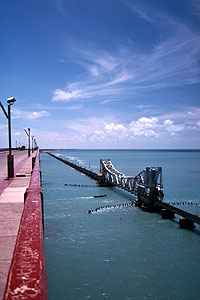
(Rameshwaram, Tamil Nadu, India)
It was a pleasant drive down a long narrow spit of land with sand dunes and blue sea either side. After 6km we got to a village, well more a ragged collection of palm leaf huts and the driver stopped. We then realised that what he had been trying to tell us was that the sand dunes has engulfed the road beyond this village. There was some talk of paying someone with a jeep 1000 Rs (about twelve pounds) to take us further but we decided that it was a nice enough spot and got out and had a walk along the beach. It was a beautiful place with a real feeling of isolation, we spent about fifteen minutes there then hopped back in the car for the long haul home.
On the way back we stopped off to take a picture of the Indira Gandhi bridge which connects the island Rameshwaram is on with the mainland. It was a remarkable feat of engineering prompted by the fact that the previous bridge had got swept away in a hurricane. However I wondered how much money had been spent connecting up a fairly small community with the mainland. It would have cost hundreds of millions and for a country with such poverty it seemed like a rather communistic statement.
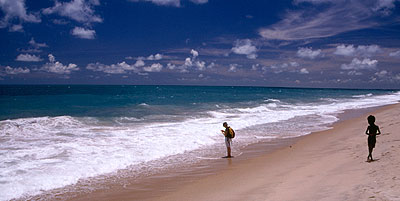
(Danuskode, Tamil Nadu, India)
By the time we got back to the hotel it was four so we had a swim and a sunbathe. Our afternoon's entertainment was the staff's attempt to catch a small mouse which had got trapped on the wide flat lip of the pools' gutter and was running around evading capture. After this we retired for Gin and Tonics over a frame of snooker followed by another great dinner overlooking Madurai by night.
Thursday, 15 April 2004
Mumbai, Maharastra, India
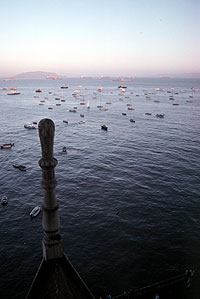
(Mumbai, Maharastra, India)
The pressure of time upon us we had decided to fly from Madurai back to Mumbai. Our flight left at 13:20 so we had decided after the rigours of the previous day to take it easy that morning with a bit of a lie in, a leisurely breakfast and a swim in the pool. We checked out and took yet another aggressively air conditioned cab to the airport. The flight was fine taking about four hours including a touch down in Chennai. At Mumbai domestic airport we caught a cab and prepared ourselves for the trip into the centre of Mumbai.
Although this was the third time we had been to the city it was the first time we were actually going to stay in the centre and we were preparing ourselves for the full horror which we had been told was Mumbai. In actual fact it was a very pleasant drive through Mumbai via Breach Candy and Chowpatty Beach, the light of the setting sun colouring everything in a rosy glow. The taxi driver tried various tricks to extract more money out of us, bizarrely including going to an LPG filling station and asking us for an advance of 200 Rs on the fare to pay for his LPG. The payment was further complicated by the fact that when coming from the airport you do not pay the rate on the meter but you have to apply a rate from a conversion card which the taxi driver seemed reluctant to show us. In the end we left a rather disgruntled taxi driver with exactly the right amount of money despite two attempts to extract higher amounts of money out of us.
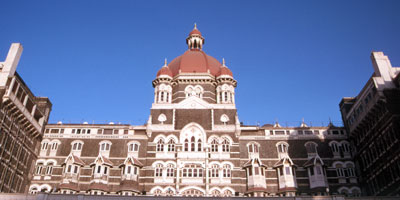
(Mumbai, Maharastra, India)
For the final night of our stay I had really gone to town, getting us a room overlooking the harbour in the superb Taj Mahal Palace. This hotel is such a Mumbai institution it gets an entry in the guide books as a tourist attraction in its own right. It was apparently built in 1903 by the Parsi industrialist JN Tata after he was refused entry to a European hotel because he was a "native". We were staying in the old part of the hotel which was a beautiful old building with an amazing huge six storey central staircase which was capped by the hotel's famous dome. Since this is an account of India I will refrain from describing some of the touches which are pretty standard for hotels of this caliber but let's just say it was very comfortable and surprisingly was not at all impersonal. We watched the last rays of the sun disappear from our vantage point just above the Gate of India and then went for a very nice meal, intentionally avoiding curry for the first time in two weeks.
Friday, 16 April 2004
Mumbai, Maharastra, India
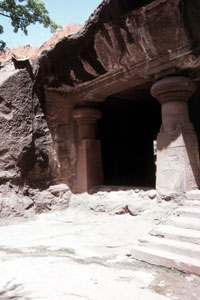
(Mumbai, Maharastra, India)
Although Mumbai has numerous attractions we decided it was high time to soak up some rays by the side of the hotel's 50m pool. At around eleven we tore ourselves away and headed out in the streets to get a ferry from the Gateway of India to Elephanta island, an island in Mumbai Harbour which has several man made caves. Outside on Apollo Bunder we got a sharp introduction to the crafty attempts to extract money out of tourists which we had missed in the South. A chap dressed in orange dodged my attempts to shoo him away by telling me that it was a religious festival and he was not selling anything. Within seconds he had wrapped a red and yellow string around my wrist, put a dot of turmeric on my forehead and gave me an orange flower. It all happened in such a short space of time I had no time to react, just keep a watch on my camera. Naturally when he was done he asked for a donation and when it looked unlikely that I would a crowd of people suddenly appeared suggesting amounts varying from 200 Rs to 500 Rs. We were certainly not going to give him that much so they had to settle for about 5 Rs in coins which he accepted in a very un religious and begrudging manner!
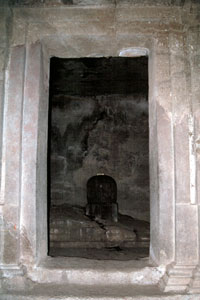
(Mumbai, Maharastra, India)
The ferries were similarly very suspicious, there seemed to be several people running around holding a few crumpled tickets for "luxury" cruises. I found one guy who at least had to rip the tickets out of a small book, so I had some degree of confidence that they were not recycled, and we jumped on a ferry that was just leaving. It was the slowest ferry in the world, taking over an hour to reach the island, but it was a very pleasant day so we just sat back and enjoyed the ride. For some reason the Indian Navy had issued a decree that no photos should be taken from the ferries, we assume because of the naval base in the harbour, however there was so little to see that it seemed a very unnecessary restriction. We passed a huge oil terminal in the harbour with a vast Greek registered oil tanker, the Sea queen, filling up.
When we got to the island it was a pretty intensive tourist trap. You first have to run the gauntlet of a long causeway full of shops and even a small railway for the very lazy. Then you have to ascend some stairs to the caves, again ignoring hundreds of erstwhile stall holders selling everything from sandalwood Ganesh statues to magic tricks. By now we had become completely immune to their attempts and they were far less annoying than the intense midday heat. It was a comparatively large 250 Rs entrance fee but at least this meant that there were no trinket sellers or guides inside the cave area.
After all this the caves were fairly pleasant. Although some of the carvings have been destroyed by various iconoclasts, including the Portuguese, there was a large amount to look at. The 6m high Mahesamurti or triple headed Shiva bust had an amazing look of serenity which was surprising considering the large number of Indians taking flash photos in front of it. Also to one side was the central shrine featuring a huge carved lingam in the middle of four intricately carved doorways. As with the various man made caves in the region the entire site had been cut out of the rock, i.e. the whole cave was just one hollowed out piece of rock.
And that was pretty much it for our trip, we took the ferry back, went for a swim and then hung around Colaba until it was time to leave for the airport. The drive back to the airport was fairly intense as the hotel had given us a driver with a huge SUV jeep thing. At every set of lights we would pull up and beggars from old to very young would start tapping on the windows. There was little we could do because we had already rid ourselves of our remaining Rupees but it highlighted the vast gulf between the very rich of Mumbai and the incredibly poor - apparently 1 million of the cities 16 million inhabitants live on the streets.
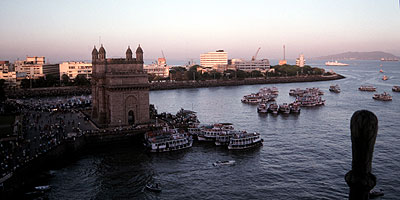
(Mumbai, Maharastra, India)
Then it was into the airport and back off to the UK on an overnight flight. The next day walking through the streets of Islington everything seemed so quiet and calm. We had a fantastic honeymoon but were very glad to be back once again. This is our idea of a good holiday, on return you should feel shell shocked and absolutely shattered and be very glad to get back to creature comforts. Perhaps one of the most notable things about travelling in the developing world is that whilst culturally very rewarding it makes you appreciate the quality of life in the west and it really puts any of the stresses of your life into perspective. If you like a holiday in the east is very much the antidote to life in the west.





